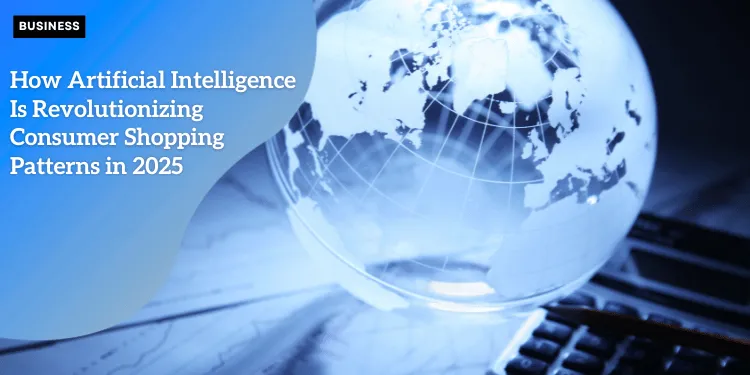How Artificial Intelligence Is Revolutionizing Consumer Shopping Patterns in 2025

Anúncios
AI Replacing Traditional Search Engines
Generative AI (GenAI) platforms, particularly ChatGPT, have significantly shifted the landscape of product recommendations.
Once dominated by traditional search engines like Google, this domain is now a playground for sophisticated AI algorithms.
Consumers are increasingly turning to GenAI for personalized and precise product suggestions.
With almost two-thirds of Gen Z, Millennials, and Gen X favoring AI-powered recommendations, the trend is unmistakable.
Anúncios
This shift indicates consumers’ preference for the tailored experiences that AI provides.
Preference for AI-Powered Recommendations
The appeal of AI-driven suggestions lies in their ability to refine and personalize the shopping experience.
Platforms like ChatGPT don’t just offer generic suggestions; they delve into consumer behavior and preferences to provide spot-on recommendations.
Anúncios
This capability explains why younger generations are particularly drawn to AI.
They’ve grown accustomed to instant, accurate results and expect the same from their shopping experiences.
AI Curating and Aggregating Product Searches
The impact of AI extends beyond recommendations.
It’s now employed to curate images and aggregate product searches across various platforms.
Consumers benefit from a streamlined experience where they can view and compare products from multiple sources without having to navigate numerous websites manually.
The integration of image curation helps in sectors like fashion and home décor, where visual appeal is paramount.
AI crafts a cohesive and rich browsing experience, making it easier for users to find exactly what they’re looking for.
By understanding these advancements, consumers are better equipped to navigate the evolving landscape of product discovery.
The next dimension to explore is how social media’s influence on shopping behavior aligns with these AI-driven changes.
 Artificial Intelligence
Artificial Intelligence
Social Media’s Growing Influence on Shopping Behavior
Shopping habits are rapidly evolving with the integration of social media into the e-commerce landscape.
The rise of social commerce is undeniable, with 32% of consumers making purchases directly through social media platforms.
This shift highlights how platforms like Instagram, TikTok, and Facebook are becoming vital in the digital shopping experience.
Discovering Products and Brands
Social media is an essential discovery tool for many consumers.
In fact, 68% of Gen Z uses social channels to find new products and brands.
This generation is known for their digital nativity and their ability to navigate through various online platforms effortlessly.
Visual and engaging content on these platforms makes product discovery not just easy but also enjoyable.
The Role of Influencers
Influencer marketing also plays a massive role in shaping purchasing decisions.
Influencers have garnered trust and loyalty from their followers, leading to a significant impact on sales.
For instance, on Cyber Monday, 20% of sales were driven by influencer marketing campaigns.
Their recommendations often feel more personal and authentic compared to traditional advertisements, making them highly effective.
Social Media’s Integration
The seamless integration of shopping features within social media apps has further streamlined the buying process.
Features like shoppable posts, in-app checkouts, and personalized ads cater to the impulse-buying tendency of users.
Consumers no longer need to leave their favorite social media platform to make a purchase, thereby enhancing convenience and driving sales.
As we journey further into the interplay between technology and consumer behavior, another major evolution reshaping retail is the development of retail media and advertising.
The Evolution of Retail Media and Advertising
The way we engage with retail media and advertising has significantly evolved.
Gone are the days when we barely noticed banner ads or were indifferent toward promotional content.
Today, retail media is a vital touchpoint in our shopping journey, influencing our decisions in subtle yet impactful ways.
Increased Visibility of Ads on Retailer Websites
A notable shift is how consumers become increasingly aware of advertisements on retailer websites.
According to a Capgemini study, 67% of consumers notice these ads.
This heightened visibility indicates that online ads are more than just background noise; they are now integrated seamlessly into our browsing experience.
Retailers have refined the art of placing these ads, ensuring that they are relevant and engaging, thereby catching the shopper’s eye more effectively than ever before.
The Role of Retail Media Ads in Shopping Decisions
Ads don’t just get noticed; they inform our shopping decisions in meaningful ways.
About 35% of shoppers report finding retail media ads helpful when making purchase choices.
These ads provide quick insights into product features, reviews, and comparative pricing, making them indispensable in a competitive market.
Discovering New Products Through Retail Media
Retail media ads also serve as a gateway to product discovery.
Approximately 22% of consumers discover new products through these advertisements.
Retailers leverage AI to ensure that these ads are targeted and suggest products that align closely with user interests and browsing behaviors.
As a result, consumers are more likely to encounter products they weren’t actively searching for but find appealing nonetheless.
The dynamic landscape of retail media and advertising is blending into our online shopping experiences, offering not just visibility but value.
This evolution is critical as it shapes how we perceive and interact with brands.
The next wave of innovation will continue to deepen retail media’s integration into our digital lives, enhancing consumer interactions and amplifying the drive towards innovation and convenience.
Price Sensitivity and Consumer Cost Strategies
As consumers navigate their shopping journeys, price sensitivity plays an increasingly crucial role.
Despite cost-of-living improvements, the hunt for the best deals remains paramount.
A considerable 64% of consumers visit multiple physical stores to find the most competitive prices.
This behavior underscores a persistent need for financial prudence and opportunism among shoppers.
Shifts Toward Low-Cost Alternatives
With inflation and economic fluctuations, consumers are becoming more discerning about their spending.
A notable 65% of shoppers now opt for private-label or low-cost brand alternatives in lieu of their pricier counterparts.
This trend reflects a shift in consumer mindset, where affordability often trumps brand loyalty.
Discount stores and generic brands are benefiting, as they fulfill the demand for cost-effective options without compromising significantly on quality.
The Unwavering Quest for Discounts
Discounts continue to play a vital role in consumer purchasing decisions.
Even as economic conditions improve, discounts retain their allure.
Retailers have noted that consumers are always on the lookout for sales, special offers, and discount codes.
This persistent behavior emphasizes that shoppers prioritize immediate savings over potential long-term benefits from branded goods.
The chapter highlights how price sensitivity influences shopper behavior and stresses the continuous demand for budget-friendly options and promotions.
Transitioning forward, we explore further aspects of how modern technology and consumer expectations are shaping the retail landscape.
The Rise of Quick Commerce and Delivery Innovation
Quick commerce has become a fundamental aspect of the modern shopping experience.
Consumers increasingly crave immediacy and convenience, valuing delivery options that accommodate their busy lifestyles.
The Demand for Speed
Approximately two-thirds of consumers now prioritize ultra-fast delivery options, such as 2-hour or even 10-minute delivery services.
The traditional waiting period for delivery seems obsolete, replaced by a burgeoning expectation for near-instant gratification.
This marked shift in consumer demands has compelled merchants to innovate rapidly to keep pace.
Convenience at the Forefront
Not only do shoppers seek quick deliveries, but 42% of them also appreciate the flexibility of order-online-pick-up-in-store options.
This hybrid model allows consumers to enjoy the speed of online shopping while maintaining the spontaneity of in-store purchases.
It effectively bridges the gap between instant online transactions and the tactile, immediate nature of brick-and-mortar shopping.
Investment in AI and Logistics
To meet these heightened expectations, merchants are increasingly turning to AI and advanced logistics systems.
AI helps optimize delivery routes, forecast demand more accurately, and manage inventory efficiently.
This investment ensures that rapid delivery is not just promised but achievable on a large scale, enhancing overall customer satisfaction and loyalty.
As the shopping landscape continues to evolve, the integration of AI in quick commerce will likely redefine consumer expectations and drive further innovations in the retail space.
The Decline of Brand Loyalty and Future Implications
Evolving Consumer Loyalty
In today’s dynamic market, traditional brand loyalty is becoming increasingly rare.
Consumers are more informed and empowered, often choosing products based on factors other than brand allegiance.
The shift is driven by various elements including the availability of information and ever-evolving consumer expectations.
The Role of AI in Brand Strategy
Brands must adapt by leveraging artificial intelligence (AI) to cater to these discerning shoppers.
By employing AI tools, brands can analyze consumer preferences and behaviors to provide personalized experiences.
These AI-driven insights help companies remain agile and responsive to consumer needs, fostering more meaningful interactions.
Personalized Recommendations
AI-powered recommendations have become a cornerstone of modern shopping experiences.
By analyzing user data, AI platforms like ChatGPT offer personalized product suggestions, which are more likely to meet consumer needs than generic advertisements.
| Benefit | Description |
|---|---|
| 🎯 Increased Personalization | AI tailors marketing messages, product recommendations, and website experiences to individual customers, enhancing the shopping journey. |
| 📊 Predictive Analytics | AI predicts future consumer behavior and trends by analyzing historical data, helping businesses optimize inventory, pricing, and marketing strategies. |
| 💬 Enhanced Customer Engagement | AI-driven tools, such as chatbots and personalized recommendations, improve real-time customer interaction, boosting engagement and satisfaction. |
Price Optimization
In addition to personalization, companies need to focus on price optimization strategies to attract price-sensitive consumers.
With 65% of shoppers opting for private-label or low-cost alternatives, competitive pricing can be a decisive factor in consumer choice.
AI can help brands dynamically adjust prices based on market trends, ensuring they offer the best value.
- 💸 Dynamic pricing models
- 📊 Competitive pricing analysis
- 🔄 Real-time market adjustments
Engaging Through Social Media
Social media continues to play a pivotal role in product discovery and brand-consumer interactions.
Brands must maintain a strong presence on social channels to stay relevant and engage with their audience.
This is especially critical as influencer marketing significantly impacts purchasing decisions.
- 📱 Consistent social media activity
- 🤝 Strategic influencer partnerships
- 🎥 Interactive and engaging content
By leveraging AI tools, optimizing prices, and maintaining robust social media engagement, brands can navigate the decline in traditional loyalty and create a more consumer-centric approach.
This shift not only helps retain customers but also ensures long-term growth and relevance in a competitive market.
To further understand the implications of declining brand loyalty, it is important to consider the ongoing advancements in quick commerce and delivery innovation…
